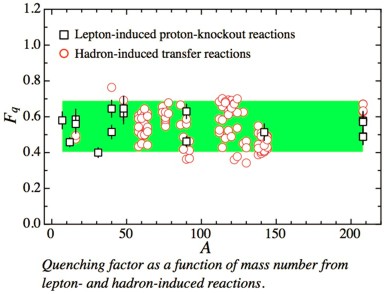Physics Division Research Highlights
Quenching of cross sections in nucleon transfer reactions
Maria Goeppert-Mayer, working at Argonne, invented the Shell Model for which she received the Nobel Prize in 1963. She realized that nuclei could be represented as protons and neutrons moving as independent particles in shells within an average potential. This model worked remarkably well for over fifty years, but it does have its limits. Recent work by Argonne scientists has explored the limitations of this ‘single-particle’ description by precision measurements of nucleon-adding and -removing reactions. They found that, remarkably, the quenching of single-particle motion arising from correlations with other nucleons is a quantitatively uniform feature of nuclei. Regardless of the type of nucleon transfer reaction, mass of the target nucleus, or other variables such as angular momentum transfer and binding energy, the degree to which single-particle motion in nuclei is quenched is by a factor of 0.55 [1].

This prescription was used to perform consistent analyses of a large body of transfer reaction data. Across the >100 cases studied, it was found that the summed single-particle strength always falls short of the single-particle limit by a factor of 0.55. It seems to be a modification of the nuclear medium, and not related to quantum configurations of the nucleons or their binding. However, interesting questions still remain as to whether this seemingly universal feature of the nuclear medium holds true for the most exotic, loosely bound nuclei, which are likely to be studied in the next decade.
References
[1] B. P. Kay, J. P. Schiffer, and S. J. Freeman, Phys. Rev. Lett. 111, 042502 (2013) (arXiv:1307.1178)
![[Argonne Logo]](/images/argonne_header_logo.jpg)
![[DOE Logo]](/images/header_doe.gif)